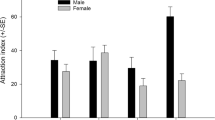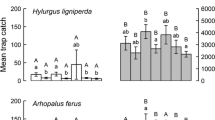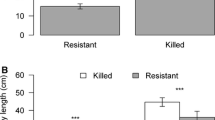Abstract
Hylurgopinus rufipes male and female beetles were attracted to American elms infected with Dutch elm disease, and to American elms killed by injection of cacodylic acid.H. rufipes was also attracted to solvent extracts of elm, or to Porapak Q-trapped volatiles from elm. The major components of attractive fractions of Porapak Q-trapped volatiles were isolated, identified, and tested in field bioassays. Several artificially compounded mixtures of sesquiterpenes were attractive toH. rufipes, although no bait tested was as attractive as diseased tree controls. Laboratory bioassays withH. rufipes were marginally successful. In laboratory bioassays, nine of 14 sequiterpenes identified from active fractions of Porapak extracts elicited significant response fromScolytus multistriatus male and female beetles: δ- and γ-cadinene, α-cubebene, γ-muurolene, and β-elemene were most active. However, in field tests, none of the sesquiterpenes alone or in combination significantly attractedS. multistriatus, nor did they significantly enhance the attraction ofS. multistriatus to female-produced pheromone components (4-methyl-3-heptanol [H] and α-multistriatin [M]). In other field tests, α-cubebene (C) significantly enhanced response ofS. multistriatus to H plus M, but foliage, logs, or chips of healthy elm did not enhance trap catch to HMC.
Similar content being viewed by others
References
Andersen, N.H., andFalcone, M.S. 1969. The identification of sesquiterpene hydrocarbons from gas-liquid Chromatograph retention data.J. Chromatogr. 44:52–59.
Andersen, N.H., Syrdal, D.D., andGraham, C. 1972. The absolute stereochemistry of the calamenenes.Tetrahedron Lett. 10:905–908.
Blight, M.M. 1981. Chemically mediated behavior ofScolytus scolytus andS. multistriatus in the United Kingdom: Studies on the role of multistriatin and host-produced compounds, pp. 427–450,in E.S. Kondo, Y. Hiratsuka and W.B.G. Denyer (eds.). Proceedings, Dutch Elm Disease Symposium and Workshop. Manitoba Department Natural Resources, Winnipeg, Canada.
Blight, M.M., Wadhams, L.J. andWenham, M.J. 1978. Volatiles associated with unmatedScolytus scolytus beetles on English elm: Differential production of α-multistriatin and 4-methyl-3-heptanol, and their activities in a laboratory bioassay.Insect. Biochem. 8:135–142.
Blight, M.M., Henderson, N.C., andWadhams, L.J. 1983. The identification of 4-methyl-3-heptanone fromScolytus scolytus (F.) andS. multistriatus (Marsham). Absolute configuration, laboratory bioassay, and electrophysiological studies onS scolytus.Insect Biochem. 13:27–38.
Borden, J.H. 1982. Secondary attraction in the Scolytidae: An annotated bibliography. Pest Management Papers, No. 25, Simon Fraser University, Burnaby, B.C., Canada, 185 pp.
Brownlee, R.G., andSilverstein, R.M. 1968. A micropreparative gas Chromatograph and a modified carbon skeleton determinator.Anal. Chem. 40:2077–2079.
Cuthbert, R. A.,Peacock, J.W., andWright, S.L. 1983. Emmission characteristics of elm bark beetle aggregation attractants from controlled-release dispensers. Northeastern Forest Experiment Station Research Paper NE-532, 11 pp.
Davies, N.W., andBignall, J.C. Undated. Identification of some essential oil components by GC and GC-MS. Internal report, Central Science Laboratory, University of Tasmania, Tasmania.
Elliott, W.J., Hromnak, G., Fried, J., andLanier, G.N. 1979. Synthesis of multistriatin enantiomers and their action onScolytus multistriatus (Coleoptera: Scolytidae).J. Chem. Ecol. 5:279–287.
French, J.R.J., Robinson, P.J., Minko, G., andPahl, P.J. 1984. Response of the European elm bark beetle,Scolytus multistriatus, to host bacterial isolates.J. Chem. Ecol. 10:1133–1149.
Gara, R.J., andVité, J.P. 1962. Studies on the flight patterns of bark beetles (Coleoptera: Scolytidae) in second growth ponderosa pine forests.Contrib. Boyce Thompson Inst. 21:275–289.
Gardiner, L.M. 1976. Control of Dutch elm disease vectors, present and future, pp. 3–20,in Workshop on Dutch Elm Disease, Winnipeg, March 3, 1976. Northern Forest Research Center, Canadian Forest Service, Edmonton, Alberta.
Gardiner, L.M. 1979. Attraction ofHylurgopinus rufipes to cacodylic acid-treated elms.Entomol. Soc. Am. Bull. 25:102–104.
Gardiner, L.M., andRoden, D.B. 1977. Rearing the Northern American native elm bark beetle.Bi-Month. Res. Notes 33:33–34.
Gore, W.E., Pearce, G.T., Lanier, G.N., Simeone, J.B., Silverstein, R.M., Peacock, J.W., andCuthbert, R.A. 1977. Aggregation attractant of the European elm bark beetle,Scolytus multistriatus. Production of individual components and related aggregation behavior.J. Chem. Ecol. 3:429–446.
Hall, S.S., McEnroe, F.J., andShue, H.-J. 1975. A convenient synthesis of the sesquiterpene (±)-α-curcumene. VI. Application of alkylation-reduction to the total synthesis of terpenes.J. Org. Chem. 40:3306–3307.
Heller, S.R., andMilne, G.W.A. 1978. EPA/NIH Mass Spectral Data Base, Vol. II. National Bureau of Standards, Washington, D.C.
Herout, V. andSykora, V. 1958. The chemistry of cadinenes and cadinols.Tetrahedron 4:246–255.
Jantz, L., andRudinsky, J.A. 1965. Laboratory and field methods for assaying olfactory responses of Douglas-fir beetle,Dendroctonus pseudotsugae Hopkins.Can. Entomol. 97:935–941.
Landwehr, V.R., Phillipsen, W.J., Ascerno, M.E., andHatch, R. 1981. Attraction of the native elm bark beetle to American elm after the pruning of branches.J. Econ. Entomol. 74:577–580.
Lanier, G.N. 1981. Pheromone baited traps and trap trees in the integrated management of bark beetles in urban areas, pp. 115–131,in E.R. Mitchell (ed.). Management of Insect Pests with Semiochemicals. Plenum, New York.
Lanier, G.N. 1983. Integration of visual stimuli, host odorants, and pheromones by bark beetles and weevils in locating and colonizing host trees, pp. 161–171,in S. Ahmad (ed.). Herbivorous Insects. Academic Press, New York.
Lanier, G.N., andBurns, B.W. 1978. Barometric flux: Effects on the responsiveness of bark beetles to aggregation attractants.J. Chem. Ecol. 4:139–147.
Lanier, G.N., Silverstein, R.M., andPeacock, J.W. 1976. Attractant pheromone of the European elm bark beetle (Scolytus multistriatus): Isolation, identification, synthesis, and utilization studies, pp. 149–175,in J.F. Anderson and H.K. Kaya (eds.). Perspectives in Forest Entomology. Academic Press, New York.
Lanier, G.N., Gore, W.E., Pearce, G.T., Peacock, J.W., andSilverstein, R.M. 1977. Response of the European elm bark beetleScolytus multistriatus (Coleoptera: Scolytidae), to isomers and components of its pheromone.J. Chem. Ecol. 3:1–8.
Martin, C.H. 1936. Preliminary report of trap-log studies on elm bark beetles.J. Econ. Entomol. 29:297–306.
Mehta, G. 1971. Silver nitrate-dimethyl sulfoxide, a powerful medium for dehydrohalogenation.Ind. J. Chem. 9:559–562.
Moeck, H.A. 1970. An olfactometer for the bioassay of attractants for scolytids.Can. Entmol. 102:792–796.
O'callaghan, D.P., Gallagher, E.M., andLanier, G.N. 1980. Field evaluation of pheromonebaited trap trees to control elm bark beetles, vectors of Dutch elm disease.Environ. Entomol. 9:181–185.
O'callaghan, D.P., Atkins, P.M., andFairhurst, C.P. 1984. Behavioral responses of elm bark beetles to baited and unbaited elms killed by cacodylic acid.J. Chem. Ecol. 10:1623–1634.
Peacock, J.W. 1979. Behavior-modifying chemicals for elm bark beetles.Entomol. Soc. Am. Bull. 25:101.
Peacock, J.W., Cuthbert, R.A., Gore, W.E., Lanier, G.N., Pearce, G.T., andSilverstein, R.M. 1975. Collection on Porapak-Q of the aggregation pheromone ofScolytus multistriatus (Coleoptera: Scolytidae).J. Chem. Ecol. 1:149–160.
Peacock, J.W., Cuthbert, R.A., andLanier, G.N. 1981. Deployment of traps in a barrier strategy to reduce populations of the European elm bark beetle and the incidence of Dutch elm disease, pp. 155–174,in E.R. Mitchell (ed.). Management of Insect Pests with Semiochemicals. Plenum, New York.
Peacock, J.W., Wright, S.L., andFord, R.D. 1984. Elm volatiles increase attraction ofScolytus multistriatus (Coleoptera: Scolytidae) to multilure.Environ. Entomol. 13:394–398.
Pearce, G.T. 1975. Chemical attractants for the European elm bark beetleScolytus multistriatus: Isolation, identification, synthesis, and biological activity. PhD thesis. State University of New York, College of Environmental Science and Forestry, Syracuse, New York.
Pearce, G.T., Gore, W.E., Silverstein, R.M., Peacock, J.W., Cuthbert, R.A., Lanier, G.N., andSimeone, J.B. 1975. Chemical attractants for the smaller European elm bark beetleScolytus multistriatus.J. Chem. Ecol. 1:115–124.
Rowe, J.W., Seikel, M.K., Roy, D.N., andJorgensen, E. 1972. Chemotaxonomy ofUlmus.Phytochemistry 11:2513–2517.
Rowe, J.W., andToda, J.K. 1969. Absolute configuration at C-4 of calamenene, 7-hydroxycalameneal and the new naturally occurring sesquiterpene, 7-hydroxycalamenene.Chem. Ind. 27:922–923.
Swigar, A.A., andSilverstein, R.M. 1981. Monoterpenes: Infrared, Mass, [1H]NMR, and [13C]NMR spectra, and Kovats' indices. Aldrich Chem. Co., Milwaukee, Wisconsin.
Thomas, A.F. 1974. Use of alicyclic derivatives as perfume agents. Swiss patent 557,421 (Cl. Cllb) C.A. 1975, 83, 131219q.
White, J.D., andRichmond, J.A. 1979. Two olfactometers for observing orientation of southern pine beetles to host odours.J. Ga. Entomol. Soc. 14:99–106.
Yukawa, Y., andIto, S. 1973. Spectral Atlas of Terpenes and the Related Compounds. Hirokawa Publishing, Tokyo.
Author information
Authors and Affiliations
Additional information
Coleoptera: Scolytidae.
Rights and permissions
About this article
Cite this article
Millar, J.G., Zhao, C.H., Lanier, G.N. et al. Components of moribund American elm trees as attractants to elm bark beetles,Hylurgopinus rufipes andScolytus multistriatus . J Chem Ecol 12, 583–608 (1986). https://doi.org/10.1007/BF01012095
Received:
Accepted:
Issue Date:
DOI: https://doi.org/10.1007/BF01012095




